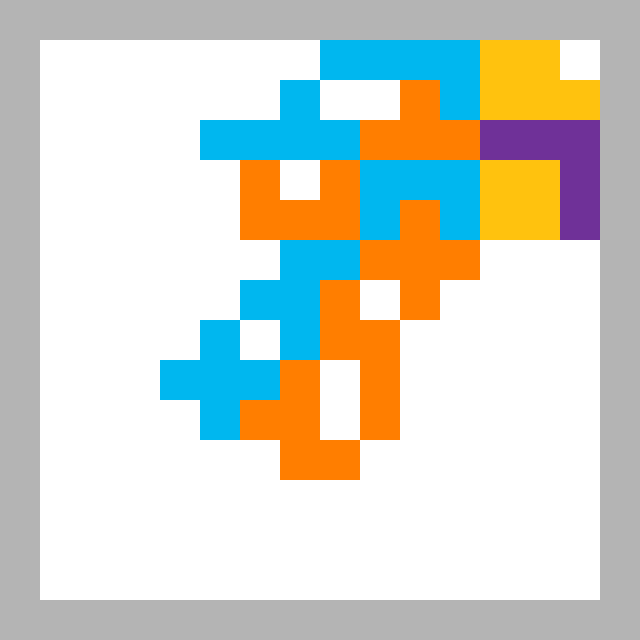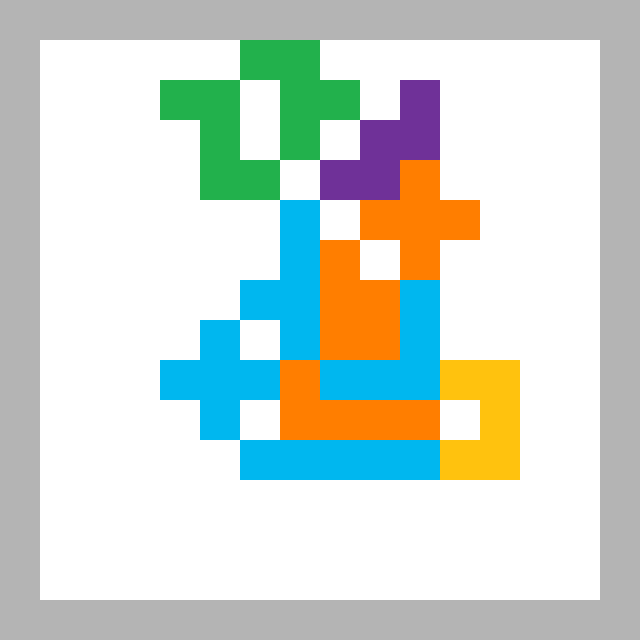Blokus Duo theory and strategies
Strategies you can use to become a better Blokus Duo player.
I'm a big fan of Blokus Duo. It's a classic example of a game that has simple rules but has surprising complexity! I've spent many hours playing Blokus Duo with my dad, and I've devised a number of effective strategies. Let me share them with you!
Since you're reading a blog post on Blokus Duo, I'll assume you've played before and know the rules. If you don't know the rules, what are you doing here, silly?
General Strategy
Play your big pieces first. This should be intuitive in a game where the goal is to maximize the number of unit squares that you can lay on the board.

See Figure 1. Orange, despite having gone first, is worse compared to Blue as a result of not playing their big pieces first. Orange has played only 20 unit squares, while Blue has played 25 unit squares. As a general rule of thumb: think carefully about playing a 4-unit piece when you still have 5-unit pieces left, and think very carefully about playing a 3-unit piece before exhausting your playable 4-unit and 5-unit pieces.
Play to the center. If you rush to the edges, your opponent will almost certainly cut you off in the center and have substantially more space for themselves.

See Figure 2. Orange is in a considerably worse position because they have not fought for the center. They only have two avenues to the left side of the board, and the little space they've carved for themselves in the right side is extremely small and won't fit many pieces.
Play in contested areas. If you have pieces that are 'secured'—ie. pieces that have guaranteed space that your opponent cannot block—generally wait to the end to play those pieces. Instead, play in areas where you are actively fighting for space.

See Figure 3. Orange should refrain from playing their secured pieces, shown in yellow, and Blue should refrain from playing their secured pices, shown in purple.
Advanced Strategy
Don't leave 'leaks'. Don't play a move that allows your opponent to reserve secured pieces. This often takes place in the unwise placement of a 'long' piece.

See Figure 4. Blue's most recent play, shown in purple, was poor. It allows Orange to have down a guaranteed 9 unit squares, shown in yellow, at the end of the game.
Be aware of a complete lock-out. Do not let your opponent completely lock you out of a large area. It's easier to miss than you'd think—especially if you're focused on a different area of the board.

See Figure 5. Orange's last move, shown in yellow, was a massive mistake. Blue's next move, shown in purple, along with future, unstoppable moves shown in green, prevent Orange from accessing the whole top-left area of the board. Orange should have taken action there before it was too late.
Pay attention to the pieces your opponent holds. It is possible to play unconventional moves, provided the piece your opponent would use to refute it has already been played. It is also possible to clog up an area so your opponent can't fit their remaining pieces effectively into that area.
As often as possible, play spiky pieces instead of smooth ones. In the beginning of the game, you want to maximize the number of possible corners to play off of. Spiky pieces have high 'corner potential': X, F, Z5, N, T5, etc. Smooth pieces have low corner potential: V5, U, I5, I4, L5, O, etc. List of piece names.

See Figure 6. Orange is in a worse position. They have less corner potential than Blue, and they will have a much harder time blocking Blue than they should.
Final Tip
The best way to improve at Blokus Duo is to consistently play with someone who is slightly better than you are. You'll start to avoid common beginner mistakes and improve your intuition for what a good move is. I hope you have fun implementing these strategies into your own Blokus Duo playstyle!